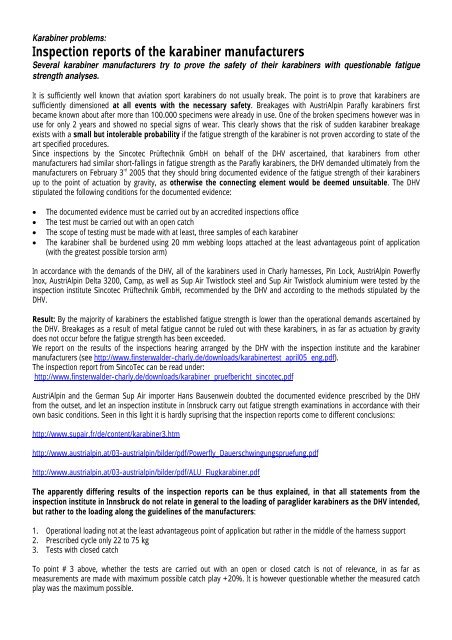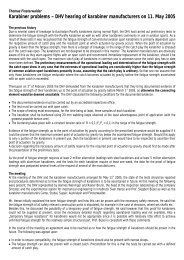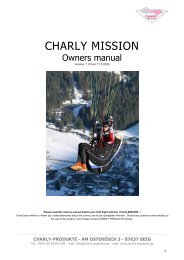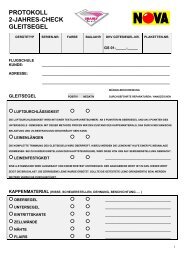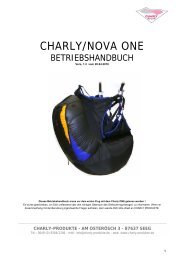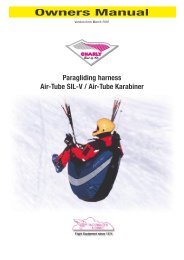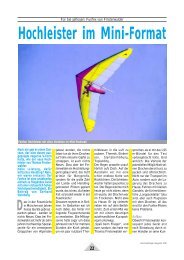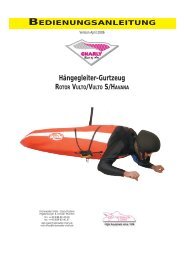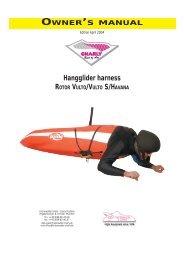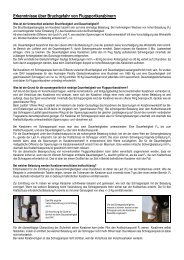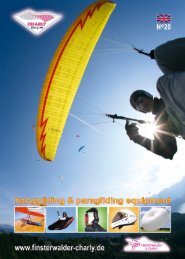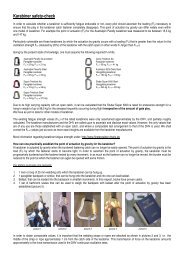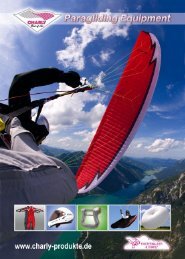Inspection reports of the karabiner manufacturers - Finsterwalder ...
Inspection reports of the karabiner manufacturers - Finsterwalder ...
Inspection reports of the karabiner manufacturers - Finsterwalder ...
Create successful ePaper yourself
Turn your PDF publications into a flip-book with our unique Google optimized e-Paper software.
Karabiner problems:<br />
<strong>Inspection</strong> <strong>reports</strong> <strong>of</strong> <strong>the</strong> <strong>karabiner</strong> <strong>manufacturers</strong><br />
Several <strong>karabiner</strong> <strong>manufacturers</strong> try to prove <strong>the</strong> safety <strong>of</strong> <strong>the</strong>ir <strong>karabiner</strong>s with questionable fatigue<br />
strength analyses.<br />
It is sufficiently well known that aviation sport <strong>karabiner</strong>s do not usually break. The point is to prove that <strong>karabiner</strong>s are<br />
sufficiently dimensioned at all events with <strong>the</strong> necessary safety. Breakages with AustriAlpin Parafly <strong>karabiner</strong>s first<br />
became known about after more than 100.000 specimens were already in use. One <strong>of</strong> <strong>the</strong> broken specimens however was in<br />
use for only 2 years and showed no special signs <strong>of</strong> wear. This clearly shows that <strong>the</strong> risk <strong>of</strong> sudden <strong>karabiner</strong> breakage<br />
exists with a small but intolerable probability if <strong>the</strong> fatigue strength <strong>of</strong> <strong>the</strong> <strong>karabiner</strong> is not proven according to state <strong>of</strong> <strong>the</strong><br />
art specified procedures.<br />
Since inspections by <strong>the</strong> Sincotec Prüftechnik GmbH on behalf <strong>of</strong> <strong>the</strong> DHV ascertained, that <strong>karabiner</strong>s from o<strong>the</strong>r<br />
<strong>manufacturers</strong> had similar short-fallings in fatigue strength as <strong>the</strong> Parafly <strong>karabiner</strong>s, <strong>the</strong> DHV demanded ultimately from <strong>the</strong><br />
<strong>manufacturers</strong> on February 3 rd 2005 that <strong>the</strong>y should bring documented evidence <strong>of</strong> <strong>the</strong> fatigue strength <strong>of</strong> <strong>the</strong>ir <strong>karabiner</strong>s<br />
up to <strong>the</strong> point <strong>of</strong> actuation by gravity, as o<strong>the</strong>rwise <strong>the</strong> connecting element would be deemed unsuitable. The DHV<br />
stipulated <strong>the</strong> following conditions for <strong>the</strong> documented evidence:<br />
• The documented evidence must be carried out by an accredited inspections <strong>of</strong>fice<br />
• The test must be carried out with an open catch<br />
• The scope <strong>of</strong> testing must be made with at least, three samples <strong>of</strong> each <strong>karabiner</strong><br />
• The <strong>karabiner</strong> shall be burdened using 20 mm webbing loops attached at <strong>the</strong> least advantageous point <strong>of</strong> application<br />
(with <strong>the</strong> greatest possible torsion arm)<br />
In accordance with <strong>the</strong> demands <strong>of</strong> <strong>the</strong> DHV, all <strong>of</strong> <strong>the</strong> <strong>karabiner</strong>s used in Charly harnesses, Pin Lock, AustriAlpin Powerfly<br />
Inox, AustriAlpin Delta 3200, Camp, as well as Sup Air Twistlock steel and Sup Air Twistlock aluminium were tested by <strong>the</strong><br />
inspection institute Sincotec Prüftechnik GmbH, recommended by <strong>the</strong> DHV and according to <strong>the</strong> methods stipulated by <strong>the</strong><br />
DHV.<br />
Result: By <strong>the</strong> majority <strong>of</strong> <strong>karabiner</strong>s <strong>the</strong> established fatigue strength is lower than <strong>the</strong> operational demands ascertained by<br />
<strong>the</strong> DHV. Breakages as a result <strong>of</strong> metal fatigue cannot be ruled out with <strong>the</strong>se <strong>karabiner</strong>s, in as far as actuation by gravity<br />
does not occur before <strong>the</strong> fatigue strength has been exceeded.<br />
We report on <strong>the</strong> results <strong>of</strong> <strong>the</strong> inspections hearing arranged by <strong>the</strong> DHV with <strong>the</strong> inspection institute and <strong>the</strong> <strong>karabiner</strong><br />
<strong>manufacturers</strong> (see http://www.finsterwalder-charly.de/downloads/<strong>karabiner</strong>test_april05_eng.pdf).<br />
The inspection report from SincoTec can be read under:<br />
http://www.finsterwalder-charly.de/downloads/<strong>karabiner</strong>_pruefbericht_sincotec.pdf<br />
AustriAlpin and <strong>the</strong> German Sup Air importer Hans Bausenwein doubted <strong>the</strong> documented evidence prescribed by <strong>the</strong> DHV<br />
from <strong>the</strong> outset, and let an inspection institute in Innsbruck carry out fatigue strength examinations in accordance with <strong>the</strong>ir<br />
own basic conditions. Seen in this light it is hardly suprising that <strong>the</strong> inspection <strong>reports</strong> come to different conclusions:<br />
http://www.supair.fr/de/content/<strong>karabiner</strong>3.htm<br />
http://www.austrialpin.at/03-austrialpin/bilder/pdf/Powerfly_Dauerschwingungspruefung.pdf<br />
http://www.austrialpin.at/03-austrialpin/bilder/pdf/ALU_Flug<strong>karabiner</strong>.pdf<br />
The apparently differing results <strong>of</strong> <strong>the</strong> inspection <strong>reports</strong> can be thus explained, in that all statements from <strong>the</strong><br />
inspection institute in Innsbruck do not relate in general to <strong>the</strong> loading <strong>of</strong> paraglider <strong>karabiner</strong>s as <strong>the</strong> DHV intended,<br />
but ra<strong>the</strong>r to <strong>the</strong> loading along <strong>the</strong> guidelines <strong>of</strong> <strong>the</strong> <strong>manufacturers</strong>:<br />
1. Operational loading not at <strong>the</strong> least advantageous point <strong>of</strong> application but ra<strong>the</strong>r in <strong>the</strong> middle <strong>of</strong> <strong>the</strong> harness support<br />
2. Prescribed cycle only 22 to 75 kg<br />
3. Tests with closed catch<br />
To point # 3 above, whe<strong>the</strong>r <strong>the</strong> tests are carried out with an open or closed catch is not <strong>of</strong> relevance, in as far as<br />
measurements are made with maximum possible catch play +20%. It is however questionable whe<strong>the</strong>r <strong>the</strong> measured catch<br />
play was <strong>the</strong> maximum possible.
To point #1 above, Also by broad harness bands, an eccentric loading <strong>of</strong> <strong>the</strong> <strong>karabiner</strong> is frequently <strong>the</strong> case. The load<br />
application in <strong>the</strong> middle <strong>of</strong> <strong>the</strong> harness support ra<strong>the</strong>r than at <strong>the</strong> edge, can make a loading difference <strong>of</strong> approximately 30%<br />
in <strong>the</strong> least advantageous case. The test results would thus only have been <strong>of</strong> any use, had accordingly higher loads been<br />
initiated.<br />
To point # 2 above, <strong>the</strong> upper limit <strong>of</strong> loading is estimated far too low at 75 kg. With a pilot weighing 100 kg, <strong>the</strong> static<br />
loading amounts to 50 kg. Depending on turbulence and flight style, <strong>the</strong> DHV measured up to 3g, amounting to 150 kg at<br />
each <strong>karabiner</strong>.<br />
The mean value <strong>of</strong> <strong>the</strong> <strong>karabiner</strong> fatigue strength as demanded by <strong>the</strong> DHV was not found. For a fatigue strength pro<strong>of</strong>, <strong>the</strong><br />
mean value <strong>of</strong> <strong>the</strong> fatigue strength must take into account <strong>the</strong> dispersion <strong>of</strong> <strong>the</strong> tests and be statistically safeguarded and<br />
reduced accordingly.<br />
For a correct pro<strong>of</strong>, <strong>the</strong> variation in cross section measurements at <strong>the</strong> critical cross section must be taken into account as<br />
well as <strong>the</strong> positive or negative reset tensions arising from <strong>the</strong> process <strong>of</strong> bending, or from <strong>the</strong> adjustment <strong>of</strong> <strong>the</strong> <strong>karabiner</strong><br />
catch play. For example by reducing <strong>the</strong> permissible catch play.<br />
In conclusion it can be said that by <strong>the</strong> tests made in Innsbruck, nei<strong>the</strong>r <strong>the</strong> fatigue strength <strong>of</strong> <strong>the</strong> <strong>karabiner</strong>s was proven,<br />
nor was a serious statement possible regarding <strong>the</strong> strength durability over time.


